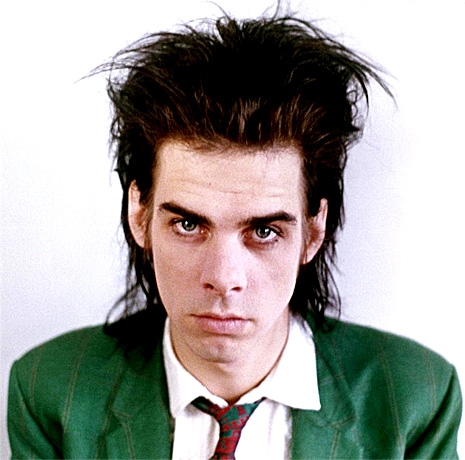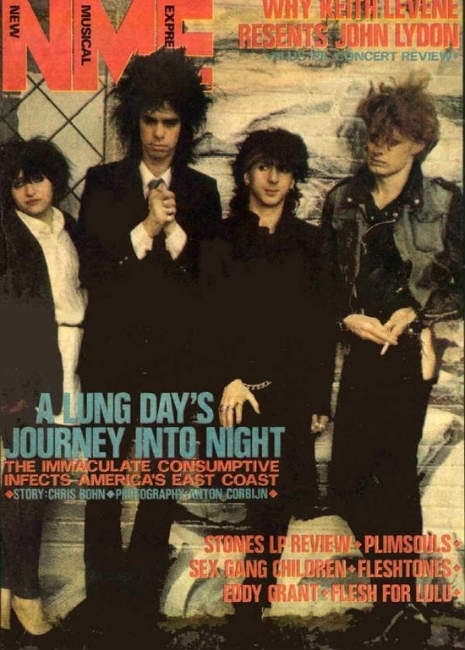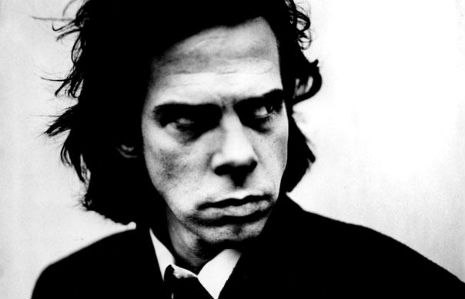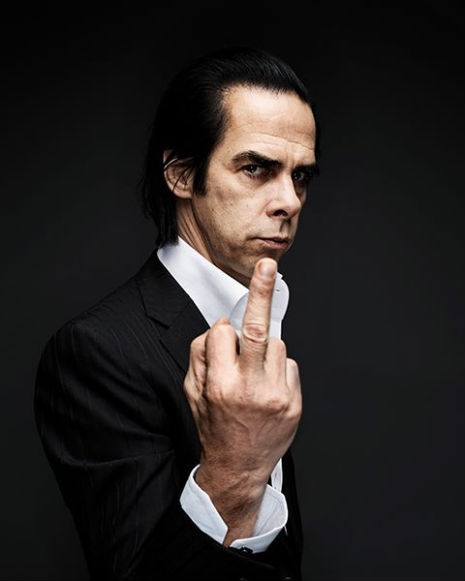
When Nick Cave and the Bad Seeds finally played the Ritz in New York City during their Your Funeral… My Trial tour, it was a makeup date, rescheduled for a Sunday in February, after an earlier, sold out Friday show the previous October had been cancelled at the very last minute. On that night, when I got to the venue, there was a large crowd of people dressed in black standing in the street outside. Mick Harvey sat atop a huge cube of equipment covered by a tarp. I asked him “What happened?” and he shrugged and threw his hands up. “We don’t know where Nick is.” (The answer, it was later revealed by the Village Voice, was that Cave had been busted copping dope in Harlem and was then sitting in jail. This was in the days before cell phones, and I am reasonably sure that Mick was fearing something far worse might have happened.)
The rescheduled date came some weeks after the end of the tour and the Sunday show was poorly attended, so it was easy to get near the stage. I stood directly in front of Cave’s mic stand. Now, I don’t want to imply that Nick Cave has mellowed out over the years—because he really hasn’t—but my favorite era of Cave’s work is from Mutiny! through Kicking Against The Pricks. “Junkie Nick Cave,” in other words. It was thrilling, almost scary, being so close to someone so seemingly unhinged and angry. Some of it didn’t necessarily seem like an act. His stage presence was fearsome and impressive, in a Keith Richards “elegantly wasted” meets Antonin Artaud sort of way. Larger than life. Cave wore a blue velvet tuxedo with a ruffle collar shirt and cuffs and he looked dead cool. His performance was so energetic and so physical that it appeared to me that heroin must have exactly the opposite effect on him that it has on most people. Or maybe he had just taken a different sort of vitamin? I don’t know, but I will say this, when the band walked offstage, the house lights stayed off, awaiting their reappearance for an encore. They stayed off for nearly ten minutes and when Cave finally staggered back onstage, his eyes were absolutely bloodshot red and he looked and acted very, very high. It seemed obvious what had caused the delay.
If I haven’t gotten the point across that this was one of the very best concerts that I’ve ever seen, it absolutely was. Cave was then, and still is, the best frontman of our time—and this was an incarnation of the Bad Seeds that included both Blixa Bargeld and Kid Congo Powers—but in the first decade of his career, he was more intense, more dangerous, more… fucking evil, basically. Today’s Nick Cave is more akin to a rambunctious revival preacher, but back then he just seemed homicidal. But, you know, in a good way.
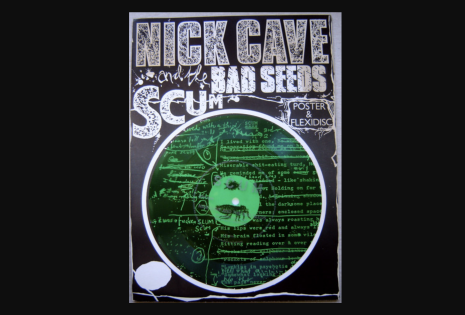
On the way out I purchased the tour program, a black and white glossy fold-out poster with a green flexi disc attached to the front. The song, titled “Scum,” was an incredibly vitriolic and outrageously spiteful diatribe that was clearly directed towards one person, that person being an NME writer who Cave had briefly been flatmates with named Matt Snow.
A sample lyric:
He was a miserable shitwringing turd
Like he reminded me of some evil gnome
Shaking hands was like shaking a hot, fat, oily bone.
Here’s another:
His and herpes bath towel type
If you know what I mean
I could not look at him, worm
OUCH!
Here’s how it ends:
I think you fucking traitor, chronic masturbator,
Shitlicker, user, self-abuser, jigger jigger!
What rock did you crawl from?
Which, did you come?
You Judas, Brutus, Vitus, Scum!
Hey four-eyes, come
That’s right, it’s a gun
Face is bubble, blood, and, street
Snowman with six holes clean into his fat fuckin gutsPsychotic drama mounts
Guts well deep then a spring is fount
I unload into his eyes
Blood springs
Dead snow
Blue skies
One needn’t wonder how Nick felt about his former flatmate, does one? Apparently what had ticked him off was a lukewarm review.
Imagine what it must feel like to hear yourself immortalized in song? But THAT song? Oh dear…
Well, apparently Matt Snow took it all in stride, and even thought if was funny, At least this is what he told the Guardian in 2008:
In 1980 my old school buddy Barney Hoskyns was writing for NME and wanted someone to go to gigs with. I became his plus one. The Birthday Party (an early band of Cave’s) were just fantastic, incredibly exciting, wild and feral, and we became part of their scene, which consisted of hanging out, playing records, doing drugs and drinking. I had a straight job and by night morphed into a nocturnal creature. It was an exciting scene to feel vicariously part of. It felt like you were living through a Velvet Underground song. I remember Nick [Cave] setting his hair on fire with a candle: everything was part-Baudelaire, part-Keith Richards. But by 1983 the Birthday Party had broken up and Nick was forming the Bad Seeds. He and his girlfriend Anita were asking for somewhere to crash for a while, and the pair moved in with me. He was still doing heroin but he was discreet. He was a good housemate. It was funny because he was always nagging Anita about her diet, yet he was shooting up! They moved down the road and we lost touch.
I raved about his From Her To Eternity album in NME but then, in a singles review, happened to drop in that the forthcoming - second - Nick Cave album “lacked the same dramatic tension”. A year or so later I found myself interviewing Nick formally for the first time. He kept me and the photographer waiting for hours. The PR was very jumpy. I got a very unusual interview. I asked him what the problem was and he said, “I think you’re an arsehole” and mentioned that he’d written a song developing this theme. Weeks later, I bought for £1 a green seven-inch flexidisc called “Scum.” I think it’s one of his best songs, and very funny. Like Dylan’s Mr Jones, I’d rather be memorialised as the spotlit object of a genius’s scorn than a dusty discographical footnote. My wife to be was a big Nick Cave fan—“Scum” is “our song.”
And there you have it.
“Scum” is included on the first volume of B-Sides & Rarities, a 3-CD set of Nick Cave and The Bad Seeds’ er… b-sides and rarities, which has now been joined by a sequel, B-Sides & Rarities Part II, a 2-CD compilation that features previously uncollected tracks from the years 2006-2019. Both sets together comprise a special limited edition seven record vinyl box set, which you can enter below to win.
Listen to “Vortex,” a previously unreleased song featured on Vol II.






